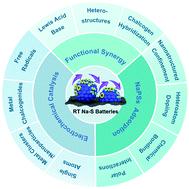当前位置:
X-MOL 学术
›
Energy Environ. Sci.
›
论文详情
Our official English website, www.x-mol.net, welcomes your feedback! (Note: you will need to create a separate account there.)
Materials engineering for adsorption and catalysis in room-temperature Na–S batteries
Energy & Environmental Science ( IF 32.5 ) Pub Date : 2021-6-17 , DOI: 10.1039/d1ee01349a Xiang Long Huang 1, 2, 3, 4 , Yun-Xiao Wang 5, 6, 7, 8 , Shu-Lei Chou 5, 6, 7, 8 , Shi Xue Dou 5, 6, 7, 8 , Zhiming M. Wang 1, 2, 3, 4
Energy & Environmental Science ( IF 32.5 ) Pub Date : 2021-6-17 , DOI: 10.1039/d1ee01349a Xiang Long Huang 1, 2, 3, 4 , Yun-Xiao Wang 5, 6, 7, 8 , Shu-Lei Chou 5, 6, 7, 8 , Shi Xue Dou 5, 6, 7, 8 , Zhiming M. Wang 1, 2, 3, 4
Affiliation

|
Room-temperature sodium–sulfur (RT Na–S) batteries constitute an extremely competitive electrochemical energy storage system, owing to their abundant natural resources, low cost, and outstanding energy density, which could potentially overcome the limitations of the current dominant lithium-ion batteries, such as their high cost and limited materials resources. Nevertheless, a severe shuttle effect and sluggish reaction kinetics are the two major obstacles that impede the sustainable development and practical application of RT Na–S batteries. Therefore, research into adsorption and catalysis strategies for the RT Na–S chemistry has attracted a great deal of interest and become the focal point of battery research in this area. In this review, we comprehensively summarize the recent advances in materials engineering for adsorption and catalysis in RT Na–S batteries. The electrochemical mechanisms and critical challenges are presented first. Various adsorption strategies with different forms and principles are then discussed, including nanostructured confinement, heteroatom doping, covalent bonding, and polar interactions. Subsequently, electrocatalysis engineering for RT Na–S batteries is comprehensively reviewed, including the topics of electrocatalysis theory, characterization methods and techniques, and design of electrocatalysts. These electrocatalysts encompass single atoms, metal clusters/nanoparticles, metal chalcogenides, and free radical species. In addition, the synergistic relationship between adsorption and catalysis is of great significance to synchronously address the issues of the shuttle effect and improved redox kinetics; hence, designs for adsorption-catalysis synergy are provided, including Lewis acid–base reactions, heterostructures, and chalcogen hybridization. Finally, significant challenges and future developmental directions regarding RT Na–S batteries are summarized and their prospects are discussed.
中文翻译:

室温钠硫电池吸附和催化的材料工程
室温钠硫(RT Na-S)电池由于其自然资源丰富、成本低、能量密度高,构成了极具竞争力的电化学储能系统,有可能克服目前占主导地位的锂离子电池的局限性。电池,例如其高成本和有限的材料资源。然而,严重的穿梭效应和缓慢的反应动力学是阻碍RT Na-S电池可持续发展和实际应用的两大障碍。因此,RT Na-S化学吸附和催化策略的研究引起了极大的兴趣,并成为该领域电池研究的重点。在这次审查中,我们全面总结了 RT Na-S 电池吸附和催化材料工程的最新进展。首先介绍电化学机制和关键挑战。然后讨论了具有不同形式和原理的各种吸附策略,包括纳米结构限制、杂原子掺杂、共价键合和极性相互作用。随后,全面回顾了RT Na-S电池的电催化工程,包括电催化理论、表征方法和技术以及电催化剂设计等主题。这些电催化剂包括单原子、金属簇/纳米颗粒、金属硫属元素化物和自由基物质。此外,吸附和催化之间的协同关系对于同步解决穿梭效应和改善氧化还原动力学问题具有重要意义;因此,提供了吸附-催化协同设计,包括路易斯酸碱反应、异质结构和硫属元素杂化。最后,总结了RT Na-S电池的重大挑战和未来发展方向,并讨论了它们的前景。
更新日期:2021-06-22
中文翻译:

室温钠硫电池吸附和催化的材料工程
室温钠硫(RT Na-S)电池由于其自然资源丰富、成本低、能量密度高,构成了极具竞争力的电化学储能系统,有可能克服目前占主导地位的锂离子电池的局限性。电池,例如其高成本和有限的材料资源。然而,严重的穿梭效应和缓慢的反应动力学是阻碍RT Na-S电池可持续发展和实际应用的两大障碍。因此,RT Na-S化学吸附和催化策略的研究引起了极大的兴趣,并成为该领域电池研究的重点。在这次审查中,我们全面总结了 RT Na-S 电池吸附和催化材料工程的最新进展。首先介绍电化学机制和关键挑战。然后讨论了具有不同形式和原理的各种吸附策略,包括纳米结构限制、杂原子掺杂、共价键合和极性相互作用。随后,全面回顾了RT Na-S电池的电催化工程,包括电催化理论、表征方法和技术以及电催化剂设计等主题。这些电催化剂包括单原子、金属簇/纳米颗粒、金属硫属元素化物和自由基物质。此外,吸附和催化之间的协同关系对于同步解决穿梭效应和改善氧化还原动力学问题具有重要意义;因此,提供了吸附-催化协同设计,包括路易斯酸碱反应、异质结构和硫属元素杂化。最后,总结了RT Na-S电池的重大挑战和未来发展方向,并讨论了它们的前景。


























 京公网安备 11010802027423号
京公网安备 11010802027423号